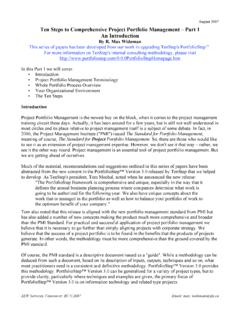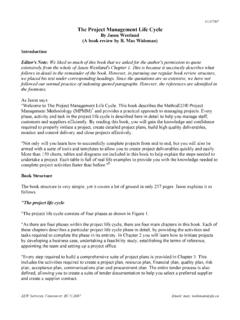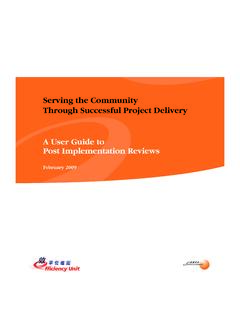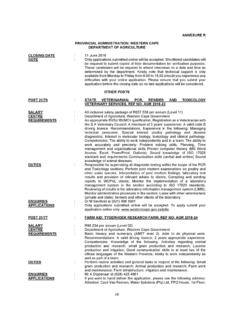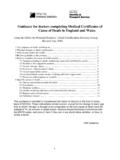Transcription of 3/5/04 Risk Management: Tricks of the Trade for …
1 3/5/04 AEW Services, Vancouver, BC 2004 Email: management : Tricks of the Trade for Project managersBy Rita Mulcahy, PMP(A book review by R. Max Wideman)Publisher RMC Publications, : Email: now and then it is nice to come across a book that really is packed full of practical and usefuladvice that you can use on projects. That distinguishes this book from those of authors who just talkabout good or new ideas but you have to figure out for yourself how to apply them! Indeed, as Ritaobserves:"In country after country, standard project management practices focus on riskmanagement.
2 Yet, in reality, most project managers and those that work on projectsignore risks by doing nothing about them .. After years of working with thousands ofproject managers from around the world, this book has been written to fill a substantialgap in international risk management knowledge. It will also attempt to correct commonerrors flagrantly noted and taken as fact in poorly documented articles and projectmanagement literature."1 Amen, to that!Rita is perhaps best known for her PMP Exam Prep materials for the Project management Institute's("PMI") PMP certification program.
3 However, according to her biography, she has "over 15 years and$ billion of hands-on project experience on hundreds of IS, IT, new product, high-tech, service,engineering, construction and manufacturing projects." Billion? In 15 years? "Hands-on"? As aconsultant? That sounds like a bit of a stretch, but we get the general structureThe structure of the book is straightforward. Successive chapters are devoted to PMI's publishedsequence of Risk management Planning; Risk Identification; Qualitative Risk analysis; QuantitativeRisk analysis; Risk Response Planning; and Risk Monitoring and Control.
4 These chapters are precededby a PMP certification look-alike test of 25 questions and a couple of chapters covering an overview andinputs into the process. The idea of the test is that you do it before you read the book, read the book, anddo it again afterwards to demonstrate how much you have learned as a result. If you think that taking thesame test twice is cheating, then there is a separate Final Exam, of 50 questions, to try instead. Ofcourse, if you are in a hurry, you can pass up on this chapters are lavishly endowed with well-organized bulleted checklists, Rita's quick-read Tricks ofthe Trade , sidebars, tables, forms, and illustrations or worked examples.
5 Each chapter concludes with aChapter Summary covering the Key Concepts described, Key Terms introduced, a couple of games andquestions for discussion. The games involve "Matching" definitions to their respective labels andidentifying "What Doesn't Belong" to relieve the monotony, help commit these things to memory andtest your Quarter Century of Project management Evolution] Page 2 of 5 AEW Services, Vancouver, BC 2004 Email: book is rounded out with four appendices, a Glossary (of risk management terms) and a briefBibliography.
6 The appendices cover: Accomplishing Risk management when Doing High-levelEstimating; Risk Categories and Lists of Risks; a Risk Chart Exercise; and finally, comments on ThePMP and CAPM we likedProject risk identification tends to be a negative exercise, especially if the project is in trouble before iteven gets going. So in that case, before moving into risk identification and response planning, Ritasuggests spending some time on identifying opportunities first to create more Or you canconduct a "Pre-Mortem" like a post-mortem except that you assume project failure and thenbrainstorm why the project has And, speaking of brainstorming and inputs, Rita provides somevery down-to-earth practical advice on how to interview an expert and what questions to collected all those risks.
7 The next problem is how to sort them into some sort of order. Rita has afun exercise for that, too. Write them all up on her custom Risk Notes, layout a large chart on the floor,showing Impact versus Probability, and let the team place them accordingly. Her experience shows that"160 risks can be sorted this way in only 20 minutes .. Interestingly, only a very small proportion ofthe risk ratings will need to be discussed."6 Chapter Seven deals with Risk Response Planning, an area that many people often find difficult, being ata loss for ideas.
8 Again, Rita provides a lot of good suggestions. So, after all of that, there should be noexcuse for anyone not knowing how to do risk management !The process of project risk management that Rita describes in her book is well integrated into PMI'smore familiar tools and techniques. But she carefully skirts round the troubling confusion in mostpeople's minds over the similarity between the five PMI management process groups of Initiating,Planning, Executing, Controlling and Closing that otherwise look uncommonly like the project life simply states "The project management life cycle follows PMI 's process groups.
9 "7 To the extentthat the principle project management processes are nested within each phase of the project life span,and indeed within each stage and succeeding breakdown of the life cycle down to the activity level, thenthe reverse must also be categorically asserts, "It is not the project manager's job to create the project charter. A projectcharter should be issued by management for every project."8 Good. But management does not alwaysknow what to put into a charter so it becomes incumbent on the project manager to provide some , creating your own terms of reference is not a bad thing, making it much easier to reach ameeting of the minds between project sponsor and project "Assumptions" Rita talks about "Risk Tolerance Areas" and observes "Tolerance areas areusually expressed in terms of the Triple Constraint: cost, time, scope of work, quality, risk andcustomer satisfaction.
10 "9 She even illustrates the statement with a hexagonal polygon. Since the TripleConstraint is usually illustrated by a triangle, the reader should not fear a feeling of beingmathematically Quarter Century of Project management Evolution] Page 3 of 5 AEW Services, Vancouver, BC 2004 Email: to Rita, "One of the top 10 reasons projects fail is that project managers do not adjust theirproject management process to the needs of each project." And "Project failure can often be attributed toa lack of adaptation of organizational policies.

